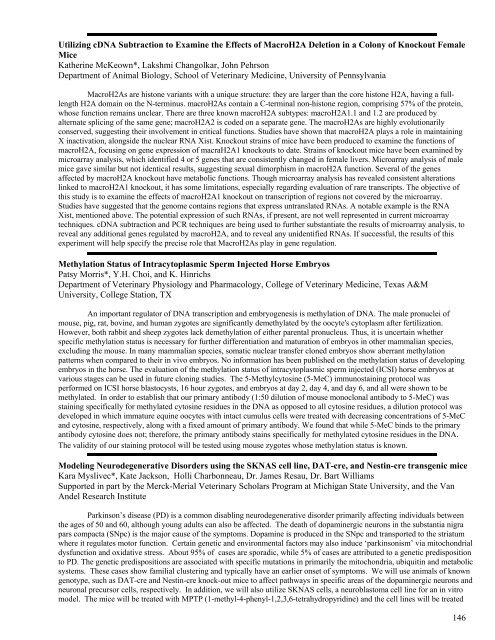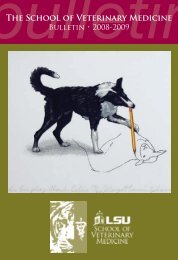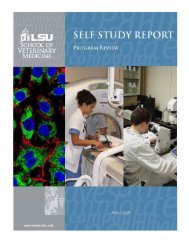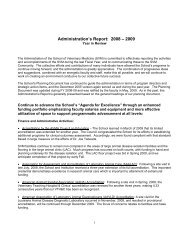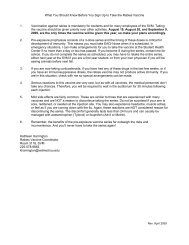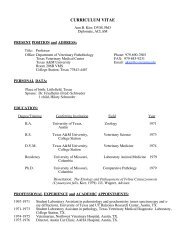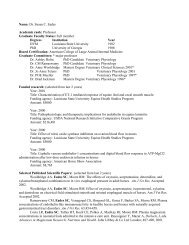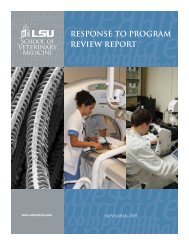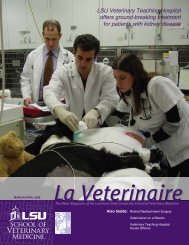Utilizing cDNA Subtraction to Examine the Effects <strong>of</strong> MacroH2A Deletion in a Colony <strong>of</strong> Knockout FemaleMiceKatherine McKeown*, Lakshmi Changolkar, John PehrsonDepartment <strong>of</strong> Animal Biology, <strong>School</strong> <strong>of</strong> <strong>Veterinary</strong> <strong>Medicine</strong>, University <strong>of</strong> PennsylvaniaMacroH2As are histone variants with a unique structure: they are larger than the core histone H2A, having a fulllengthH2A domain on the N-terminus. macroH2As contain a C-terminal non-histone region, comprising 57% <strong>of</strong> the protein,whose function remains unclear. There are three known macroH2A subtypes: macroH2A1.1 and 1.2 are produced byalternate splicing <strong>of</strong> the same gene; macroH2A2 is coded on a separate gene. The macroH2As are highly evolutionarilyconserved, suggesting their involvement in critical functions. Studies have shown that macroH2A plays a role in maintainingX inactivation, alongside the nuclear RNA Xist. Knockout strains <strong>of</strong> mice have been produced to examine the functions <strong>of</strong>macroH2A, focusing on gene expression <strong>of</strong> macraH2A1 knockouts to date. Strains <strong>of</strong> knockout mice have been examined bymicroarray analysis, which identified 4 or 5 genes that are consistently changed in female livers. Microarray analysis <strong>of</strong> malemice gave similar but not identical results, suggesting sexual dimorphism in macroH2A function. Several <strong>of</strong> the genesaffected by macroH2A knockout have metabolic functions. Though microarray analysis has revealed consistent alterationslinked to macroH2A1 knockout, it has some limitations, especially regarding evaluation <strong>of</strong> rare transcripts. The objective <strong>of</strong>this study is to examine the effects <strong>of</strong> macroH2A1 knockout on transcription <strong>of</strong> regions not covered by the microarray.Studies have suggested that the genome contains regions that express untranslated RNAs. A notable example is the RNAXist, mentioned above. The potential expression <strong>of</strong> such RNAs, if present, are not well represented in current microarraytechniques. cDNA subtraction and PCR techniques are being used to further substantiate the results <strong>of</strong> microarray analysis, toreveal any additional genes regulated by macroH2A, and to reveal any unidentified RNAs. If successful, the results <strong>of</strong> thisexperiment will help specify the precise role that MacroH2As play in gene regulation.Methylation Status <strong>of</strong> Intracytoplasmic Sperm Injected Horse EmbryosPatsy Morris*, Y.H. Choi, and K. HinrichsDepartment <strong>of</strong> <strong>Veterinary</strong> Physiology and Pharmacology, College <strong>of</strong> <strong>Veterinary</strong> <strong>Medicine</strong>, Texas A&MUniversity, College Station, TXAn important regulator <strong>of</strong> DNA transcription and embryogenesis is methylation <strong>of</strong> DNA. The male pronuclei <strong>of</strong>mouse, pig, rat, bovine, and human zygotes are significantly demethylated by the oocyte's cytoplasm after fertilization.However, both rabbit and sheep zygotes lack demethylation <strong>of</strong> either parental pronucleus. Thus, it is uncertain whetherspecific methylation status is necessary for further differentiation and maturation <strong>of</strong> embryos in other mammalian species,excluding the mouse. In many mammalian species, somatic nuclear transfer cloned embryos show aberrant methylationpatterns when compared to their in vivo embryos. No information has been published on the methylation status <strong>of</strong> developingembryos in the horse. The evaluation <strong>of</strong> the methylation status <strong>of</strong> intracytoplasmic sperm injected (ICSI) horse embryos atvarious stages can be used in future cloning studies. The 5-Methylcytosine (5-MeC) immunostaining protocol wasperformed on ICSI horse blastocysts, 16 hour zygotes, and embryos at day 2, day 4, and day 6, and all were shown to bemethylated. In order to establish that our primary antibody (1:50 dilution <strong>of</strong> mouse monoclonal antibody to 5-MeC) wasstaining specifically for methylated cytosine residues in the DNA as opposed to all cytosine residues, a dilution protocol wasdeveloped in which immature equine oocytes with intact cumulus cells were treated with decreasing concentrations <strong>of</strong> 5-MeCand cytosine, respectively, along with a fixed amount <strong>of</strong> primary antibody. We found that while 5-MeC binds to the primaryantibody cytosine does not; therefore, the primary antibody stains specifically for methylated cytosine residues in the DNA.The validity <strong>of</strong> our staining protocol will be tested using mouse zygotes whose methylation status is known.Modeling Neurodegenerative Disorders using the SKNAS cell line, DAT-cre, and Nestin-cre transgenic miceKara Myslivec*, Kate Jackson, Holli Charbonneau, Dr. James Resau, Dr. Bart WilliamsSupported in part by the Merck-Merial <strong>Veterinary</strong> Scholars Program at Michigan <strong>State</strong> University, and the VanAndel Research InstituteParkinson’s disease (PD) is a common disabling neurodegenerative disorder primarily affecting individuals betweenthe ages <strong>of</strong> 50 and 60, although young adults can also be affected. The death <strong>of</strong> dopaminergic neurons in the substantia nigrapars compacta (SNpc) is the major cause <strong>of</strong> the symptoms. Dopamine is produced in the SNpc and transported to the striatumwhere it regulates motor function. Certain genetic and environmental factors may also induce ‘parkinsonism’ via mitochondrialdysfunction and oxidative stress. About 95% <strong>of</strong> cases are sporadic, while 5% <strong>of</strong> cases are attributed to a genetic predispositionto PD. The genetic predispositions are associated with specific mutations in primarily the mitochondria, ubiquitin and metabolicsystems. These cases show familial clustering and typically have an earlier onset <strong>of</strong> symptoms. We will use animals <strong>of</strong> knowngenotype, such as DAT-cre and Nestin-cre knock-out mice to affect pathways in specific areas <strong>of</strong> the dopaminergic neurons andneuronal precursor cells, respectively. In addition, we will also utilize SKNAS cells, a neuroblastoma cell line for an in vitromodel. The mice will be treated with MPTP (1-methyl-4-phenyl-1,2,3,6-tetrahydropyridine) and the cell lines will be treated146
with MPP+, the active metabolite <strong>of</strong> MPTP. Using tissues, fluids and cells from a mouse model <strong>of</strong> known genotype, we willcharacterize changes in the mRNA gene expression that follows MPTP treatment <strong>of</strong> mice. Changes in the pattern and type <strong>of</strong>gene expression will be correlated with onset <strong>of</strong> PD symptoms. Hierarchical clustering will be used to determine if there is agenotype or hierarchical separation that distinguishes PD from other forms <strong>of</strong> injury and degeneration. We predict significantchanges in the metabolic, ubiquitin/proteasome system and apoptotic processes over time in these models.Rescue <strong>of</strong> the Cystic Phenotype in a Zebrafish bicc1 Model <strong>of</strong> Polycystic Kidney Disease Using the MouseBicc1 GeneB. Victoria Nelson 1 *, Denise Bouvrette 1 , Anand Chandrasekhar 2 , Elizabeth C. Bryda1Department <strong>of</strong> <strong>Veterinary</strong> Pathobiology, College <strong>of</strong> <strong>Veterinary</strong> <strong>Medicine</strong>, University <strong>of</strong> Missouri, Columbia,MO. 1 , Department <strong>of</strong> Biological Sciences, University <strong>of</strong> Missouri, Columbia, MO 2Polycystic kidney disease (PKD) is an inherited disorder affecting nearly 600,000 Americans. Clinical signs includerenal enlargement, progressive cyst formation, and ultimately end-stage renal disease. Bicaudal-C (mBicc1) is the diseasecausinggene in the jcpk PKD mouse model. Mutations in mBicc1 cause a phenotype in mouse closely resembling clinicalpathology seen in PKD patients. The mouse Bicc1 protein contains two functional domains: three KH domains and a SAMdomain. The functional role <strong>of</strong> Bicc1 in the kidney is unknown. Zebrafish <strong>of</strong>fer an attractive alternative to rodent PKDmodels due to 1) ease <strong>of</strong> visualizing organs and tissues in embryos and juveniles, 2) conservation <strong>of</strong> genetic pathwaysregulating organogenesis, and 3) ability to rapidly assay loss- and gain-<strong>of</strong> function phenotypes for any gene. The zebrafishpronephros develops during the first two days following fertilization and the morphogenetic events are similar to those inmammalian kidney development. We have shown that loss <strong>of</strong> zebrafish bicc1 in pronephric tissue leads to cyst formation inkidney tubules mimicking the mouse phenotype. Comparisons <strong>of</strong> mouse and zebrafish Bicaudal-C indicate a high degree <strong>of</strong>conservation at both the nucleotide and amino acid levels, particularly over the KH and SAM domains. Since zbicc1 andmBicc1 functional domains share a high degree <strong>of</strong> similarity, and lack <strong>of</strong> Bicc1 leads to cyst formation in both zebrafish andmouse, our hypothesis is that zbicc1 and mBicc1 serve identical functions in the kidney. We will use the mouse Bicc1 gene torescue zebrafish bicc1 morphants in which the expression <strong>of</strong> endogenous zbicc1 is eliminated. The expectation is that ifmBicc1 has the same function as zbicc1, zbicc1 knockdown zebrafish morphant embryos carrying the mBicc1 gene will nothave the expected cystic phenotype. Success <strong>of</strong> this experiment will support the use <strong>of</strong> the zbicc1 zebrafish model as analternative to the mouse model to better understand the role <strong>of</strong> Bicc1 in kidney development and renal cyst formation.Differentiation <strong>of</strong> Adult Derived Stem Cells into Neural SubtypesLaura J. Pasieniuk* and Elmer M. PriceUniversity <strong>of</strong> Missouri, College <strong>of</strong> <strong>Veterinary</strong> <strong>Medicine</strong> and Dalton Cardiovascular Research CenterThe therapeutic use <strong>of</strong> stem cells is a promising avenue emerging in science. Embryonic sources were the firstknown providers <strong>of</strong> stem cells, yet in recent years adult sources <strong>of</strong> stem cells have been discovered in bone marrow andperipheral blood. Peripheral blood draws from green fluorescent pigs have yielded stem cells with multipotent capabilities.These cells, known as peripheral blood derived multipotent adult progenitor cells (PBD-MAPCs), have been shown todifferentiate into five different cell types including adipocytes, osteoblasts, endothelial cells, smooth muscle cells and mostinteresting, neural cells. PBC-MAPCs are maintained in an undifferentiated state as spheroids which possess the ability tochange into different cell types depending on the signals they receive. The goal <strong>of</strong> this project is to define these factors ormechanisms that define neurogenesis, particularly into oligodendrocytes and dopaminergic neurons. This process begins byplating PBD-MAPCs on MatrigelTM and feeding the cells media containing fetal bovine serum. When exposed to theseconditions PBD-MAPCs express several different neural markers including NeuN, TH, MAP 2a+b, MPB, GFAP, and beta-3tubulin. Our goal is to explore the effects <strong>of</strong> BMP-4, BDNF, NGF, Netrin-1, Semaphorin 3a, and FGF8. The analysis <strong>of</strong>these specific factors will allow us to evaluate the expression <strong>of</strong> specific neural subtypes for therapeutics in areas such asspinal cord injury and Parkinson’s disease.The Induction <strong>of</strong> SPP1 in Ovine Endometrial Glandular Epithelium and Stroma Requires Progesterone,but is Augmented to Maximal Production by Conceptus AttachmentKM Reed 1 , KA Dunlap 1 , FJ White 1 , JL Farmer 2 , RC Burghardt 1 , TE Spencer 2 , GA Johnson 1Departments <strong>of</strong> <strong>Veterinary</strong> Integrative Biosciences 1 and Animal Science 2 , Texas A&M University, CollegeStation, TX 77843-4458Secreted Phosphoprotein 1 (SPP1) is an integrin-binding extracellular matrix protein which has been implicated as acontributor to implantation and fetal development. Our objective was to determine the regulation <strong>of</strong> SPP1 in endometrialstroma and glandular epithelium (GE) <strong>of</strong> sheep. During seasonal anestrus, adult virgin control and Uterine Gland Knockout(UGKO) ewes were hemi-ovariohysterectomized (Day 0) and then received daily injections <strong>of</strong> progesterone. On Day 60, theremaining uterine horn was recovered. In control ewes, SPP1 mRNA was induced in uterine glands and stroma whereas inUGKO ewes SPP1 mRNA was induced in stroma <strong>of</strong> both caruncular and intercaruncular regions. We also examined SPP1147
- Page 1 and 2:
2006 MERCK/MERIALNATIONAL VETERINAR
- Page 6 and 7:
3:00-3:30 pm BreakNovel therapy for
- Page 8 and 9:
KEYNOTE SPEAKERRonald Veazey, D.V.M
- Page 10 and 11:
Mini Symposium II:Fish Research: A
- Page 12 and 13:
David G. Baker, D.V.M., M.S., Ph.D.
- Page 14 and 15:
Konstantin G. Kousoulas, Ph.D.Profe
- Page 16 and 17:
Joseph Francis, B.V.Sc., M.V.Sc., P
- Page 18 and 19:
dogs with cancer, the potential rol
- Page 20 and 21:
2006 MERCK/MERIALVETERINARY SCHOLAR
- Page 22 and 23:
YOUNG INVESTIGATOR AWARD HONORABLE
- Page 24 and 25:
Mammary epithelial-specific deletio
- Page 26 and 27:
2006 MERCK/MERIALVETERINARY SCHOLAR
- Page 28:
Variation in Q-Tract Length of the
- Page 34:
Novel therapy for humoral hypercalc
- Page 38:
ALTERNATE:Micron-scale membrane sub
- Page 42 and 43:
ABSTRACT TITLES LISTED BY CATEGORY
- Page 44 and 45:
19. A pilot study of cigarette smok
- Page 46 and 47:
36. Development of a murine in vitr
- Page 48 and 49:
ABSTRACT TITLES LISTED BY CATEGORY
- Page 50 and 51:
71. Identification and characteriza
- Page 52 and 53:
85. Age and Gender Influence Ventil
- Page 54 and 55:
ABSTRACT TITLES LISTED BY CATEGORY
- Page 56 and 57:
2006 MERCK/MERIALVETERINARY SCHOLAR
- Page 58 and 59:
10. Preliminary estimation of risk
- Page 60 and 61:
ABSTRACT TITLES LISTED BY CATEGORY
- Page 62 and 63:
47. Osteoprotegerin and Receptor Ac
- Page 64 and 65:
61. A Comparison of Interaction Pat
- Page 66 and 67:
ABSTRACT TITLES LISTED BY CATEGORY
- Page 68 and 69:
ABSTRACT TITLES LISTED BY CATEGORY
- Page 70 and 71:
ABSTRACT TITLES LISTED BY CATEGORY
- Page 72 and 73:
2006 MERCK/MERIALVETERINARY SCHOLAR
- Page 74 and 75:
used to label avian heterophils for
- Page 76 and 77:
obtained via analysis of time and d
- Page 78 and 79:
0.71mg/dL; p=0.001). Values for hem
- Page 80 and 81:
mass and fecundity in prespawning w
- Page 82 and 83:
Equine Hoof Laminae Tissue Collecti
- Page 84 and 85:
Aspiration Pneumonia in DogsDavid A
- Page 86 and 87:
Distortion Product Otoacoustic Emis
- Page 88 and 89:
tyrosine phosphorylation is measure
- Page 90 and 91:
the gravid and non-gravid females t
- Page 92 and 93:
egulatory function as its ortholog,
- Page 94 and 95:
PATHOLOGY, TOXICOLOGY, AND ONCOLOGY
- Page 96 and 97: Markers of Oxidative Stress in plas
- Page 98 and 99: has been isolated from all samples
- Page 100 and 101: Matrix metalloproteinase secretion
- Page 102 and 103: Reproductive performance, neonatal
- Page 104 and 105: control to determine the efficiency
- Page 106 and 107: Enhancing the Quality and Reliabili
- Page 108 and 109: grade II MCTs into groups with good
- Page 110 and 111: Transcriptional Regulation of the I
- Page 112 and 113: MICROBIOLOGY AND IMMUNOLOGY (SESSIO
- Page 114 and 115: colonization of the mutant and 6 re
- Page 116 and 117: digestive tracts of these and other
- Page 118 and 119: 100 pfu BRSV. The results show that
- Page 120 and 121: Inhibition of Microneme Secretion i
- Page 122 and 123: Adherent bacilli were present in th
- Page 124 and 125: isolated to analyze cytokine gene e
- Page 126 and 127: purified, viral RNA was extracted a
- Page 128 and 129: The effects of co-engagement of TLR
- Page 130 and 131: Occurrence of Leptospira Vaccine Fa
- Page 132 and 133: undifferentiated catecholaminergic
- Page 134 and 135: the concept that the greater detoxi
- Page 136 and 137: quantitative PCR using gene targets
- Page 138 and 139: Rotenone Induced Dopamine Neuron De
- Page 140 and 141: decrease in serum cortisol, with a
- Page 142 and 143: and detrimental impacts on the brai
- Page 144 and 145: actions of cells prior to embryo de
- Page 148 and 149: expression in unilaterally pregnant
- Page 150 and 151: Salmonella is increased. Poultry sa
- Page 152 and 153: exports. The estimated prevalence o
- Page 154 and 155: eeding grounds near Minnedosa, MB s
- Page 156 and 157: (PBMC) were isolated using commerci
- Page 158 and 159: 2006 MERCK/MERIALVETERINARY SCHOLAR
- Page 160 and 161: Trainees acquire in-depth knowledge
- Page 162 and 163: comparative pathology and/or resear
- Page 164 and 165: Department of Veterinary Bioscience
- Page 166 and 167: PhD, Director, Center for Comparati
- Page 168 and 169: 2006 MERCK/MERIALVETERINARY SCHOLAR
- Page 170 and 171: MICHIGAN STATEUNIVERSITYJames Crawf
- Page 172: UNIVERSITY OFPENNSYLVANIALindsay Th


